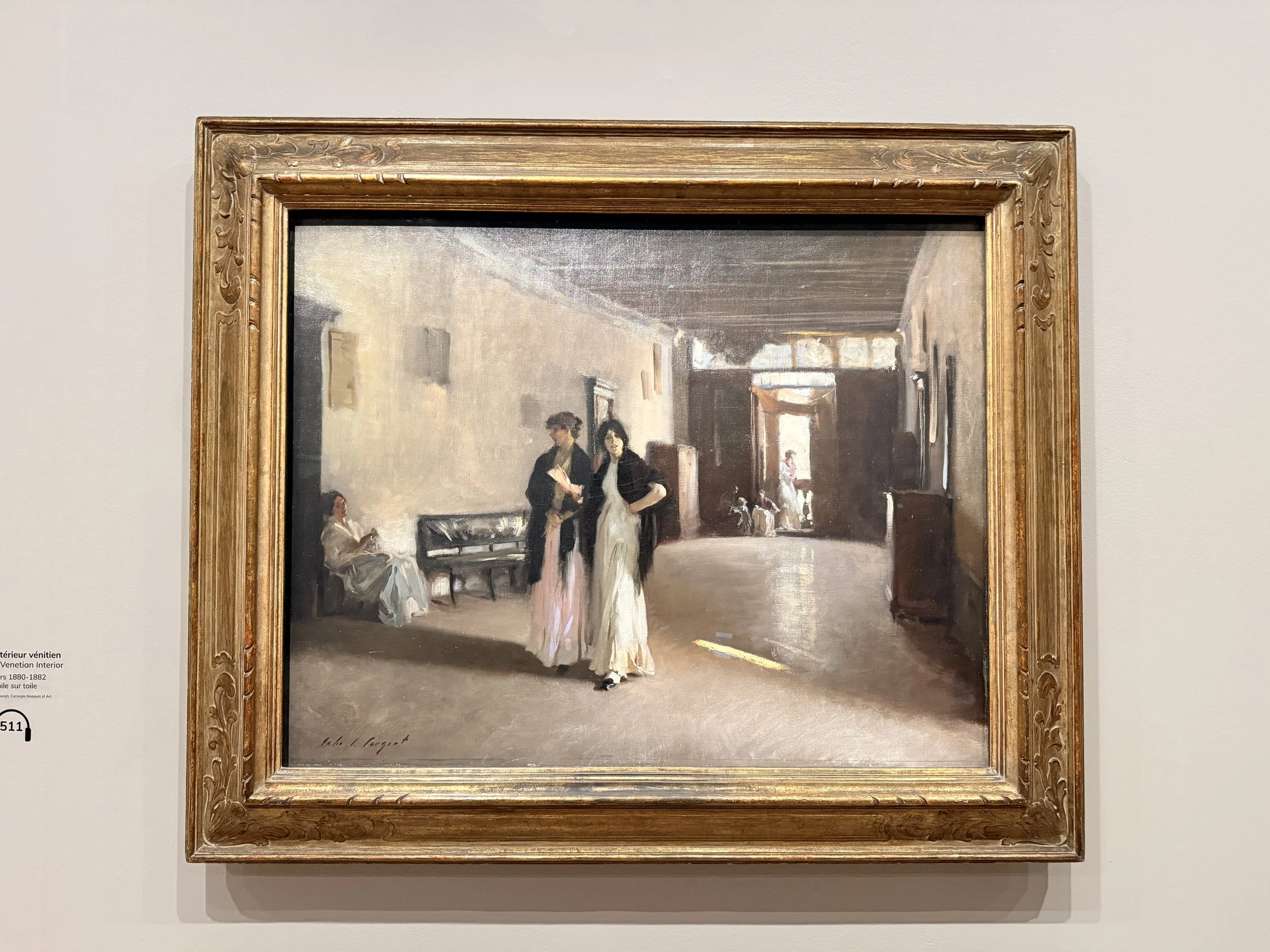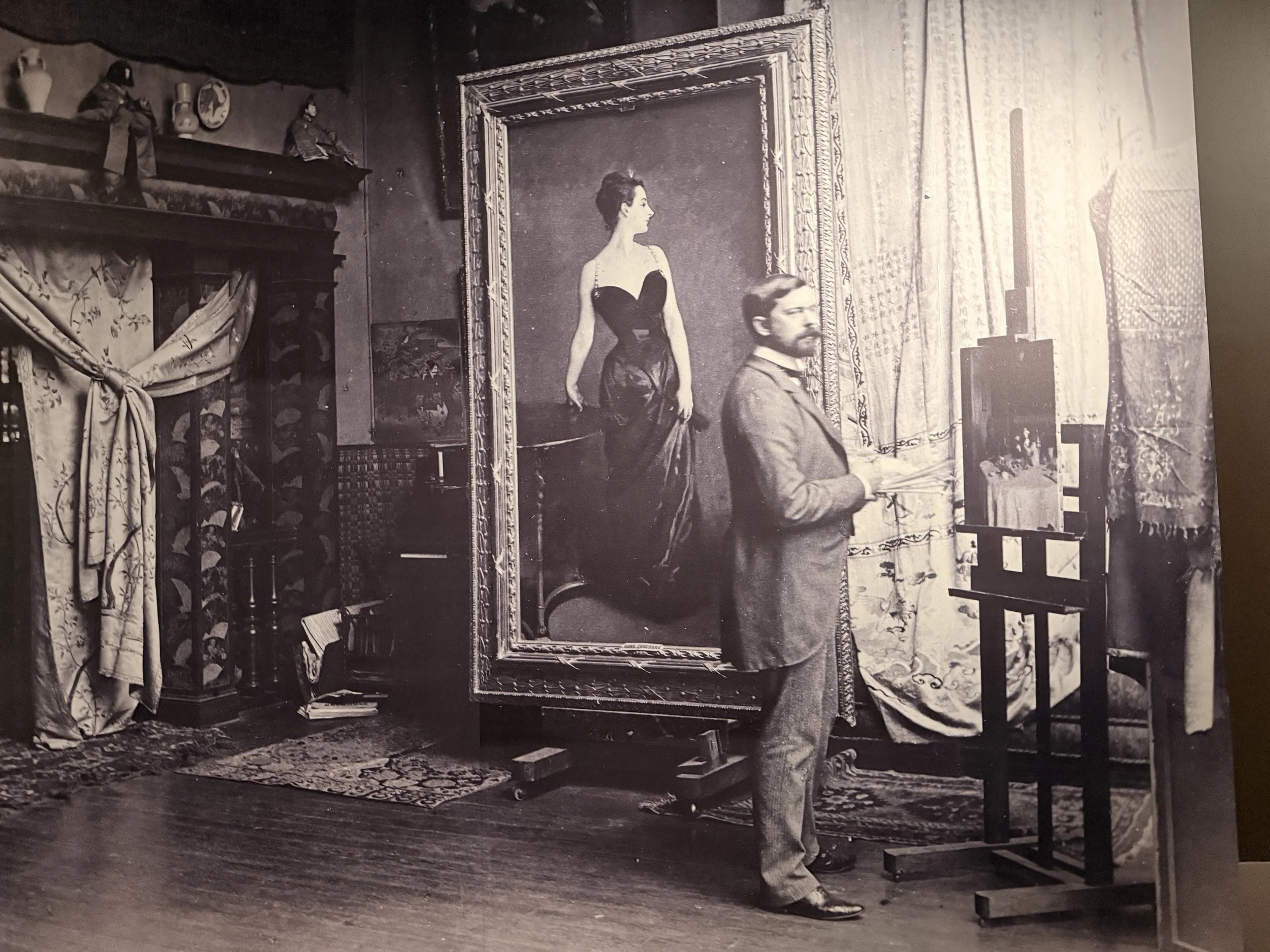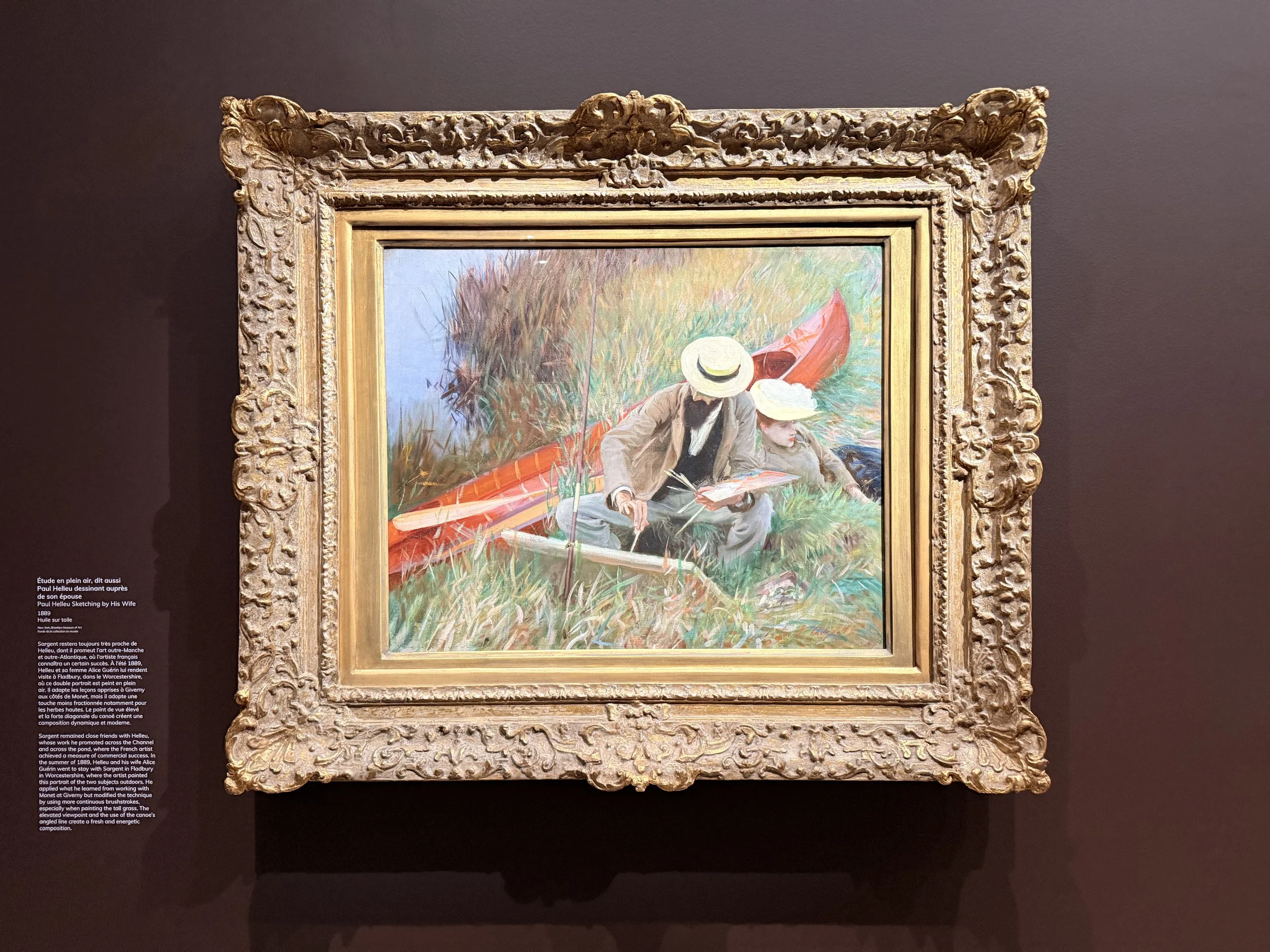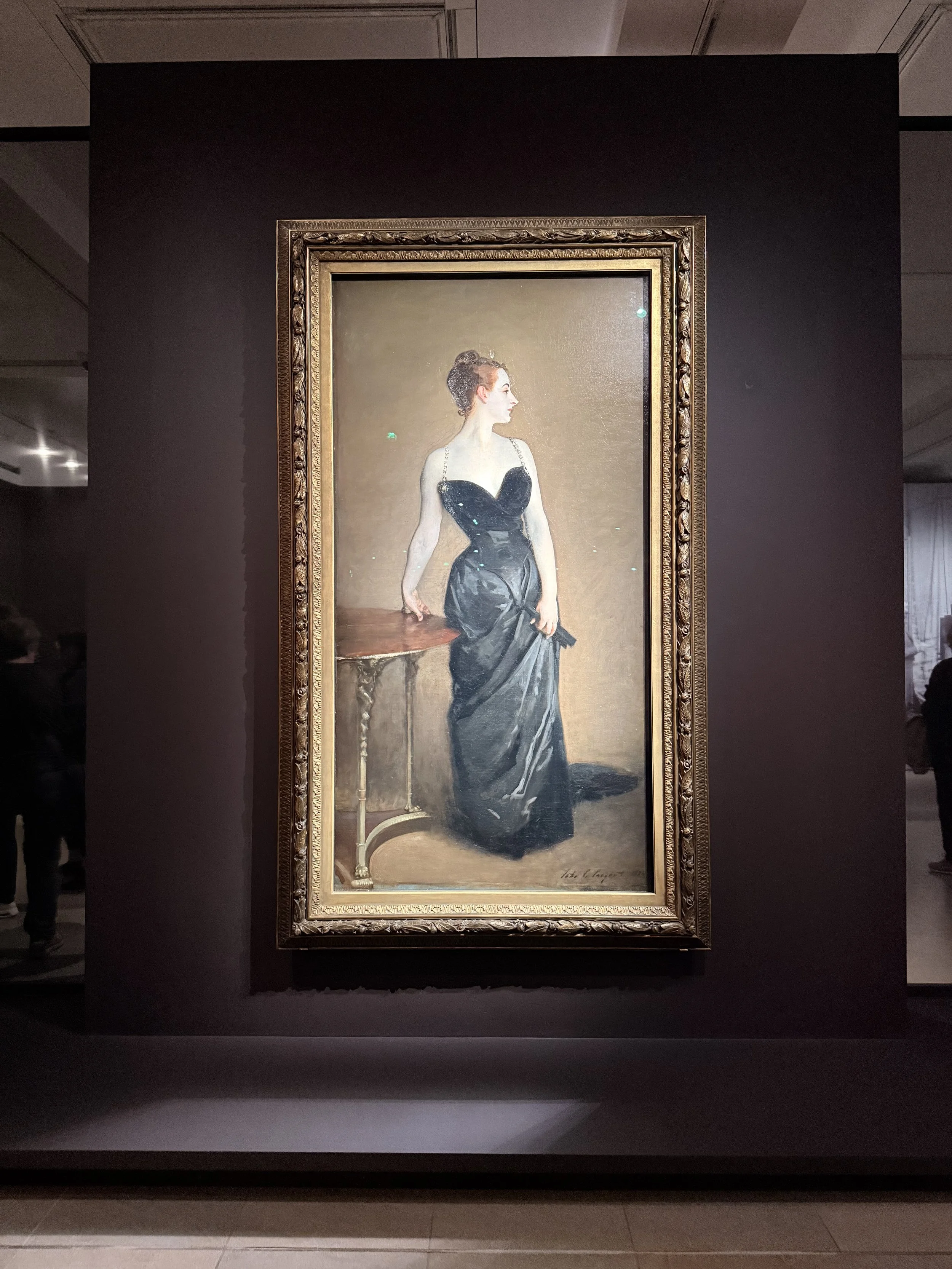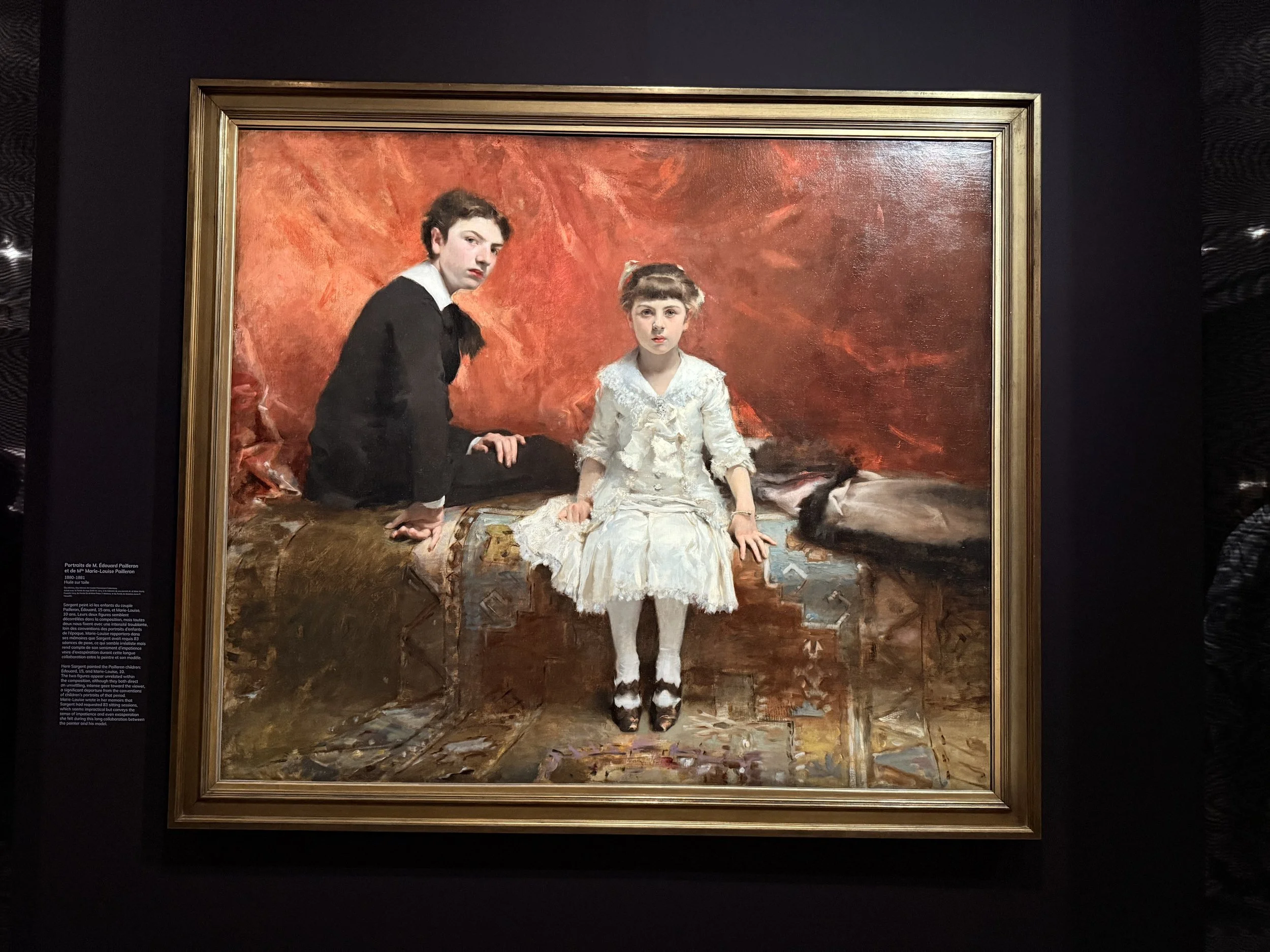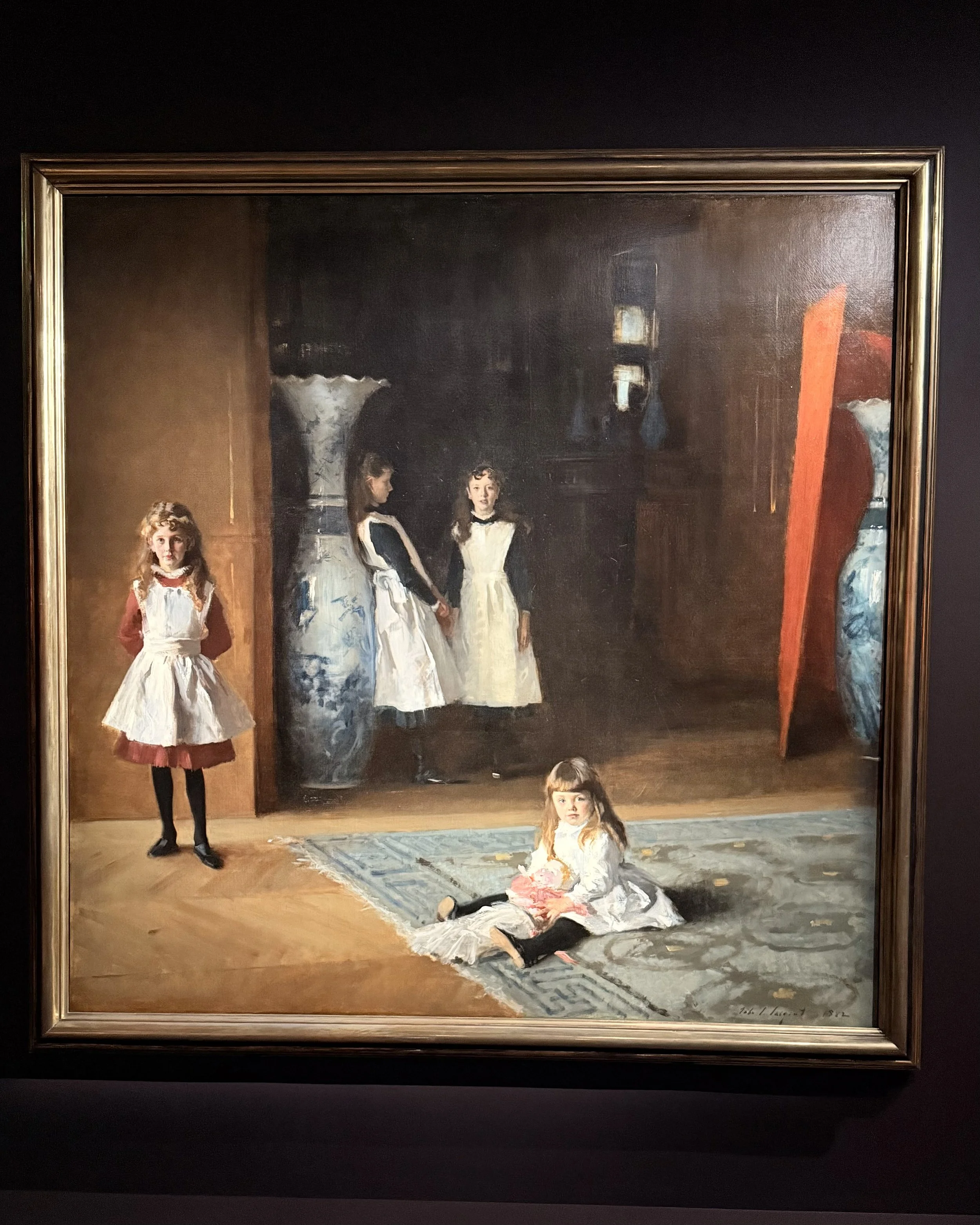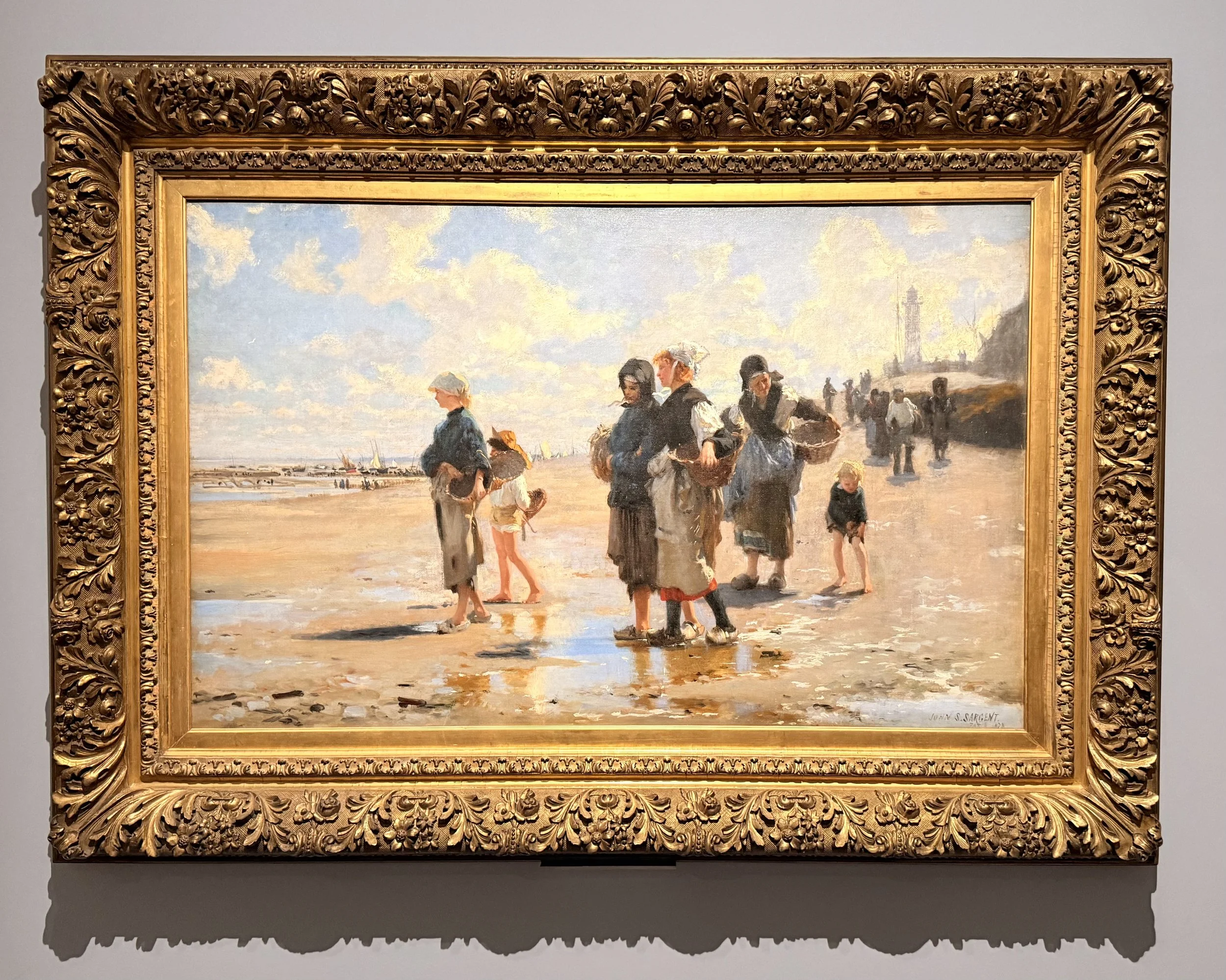The Paris Exhibition That's Captivating Locals, PLUS Four Afternoon Itineraries
My content is completely free, no paywalls or subscriptions. Just like those old-school ‘90s blogs we used to love. 🥰
The John Singer Sargent exhibition at the Musée d'Orsay has done something remarkable. It's not just assembled an extraordinary collection of works from Chicago, New York, San Francisco, private collections, and the Tate. It's reminded us why certain artists transcend their time, speaking to something essential about how we see ourselves and our world.
Walking through this exhibition, which easily takes an hour and a half to properly absorb, I found myself returning to certain paintings again and again. Not just for their technical mastery, though Sargent's ability to capture light on skin, fabric, and water remains unmatched. But for what they reveal about the artist's obsessions: society and scandal, childhood innocence, the play of light itself, and the landscapes that shaped him.
Understanding John Singer Sargent: The Basics
Before we dive into the exhibition and the Paris itineraries it inspired, let's establish context. John Singer Sargent (1856-1925) was born in Florence to American expatriate parents. Though claimed by America as one of their greatest artists, his career was truly made in Paris. He studied here, exhibited at the Paris Salon, and it was here that both his greatest triumph and most devastating scandal occurred.
Sargent is that rare artist who mastered multiple genres. His society portraits captured Gilded Age wealth with both glamour and psychological insight. His watercolor landscapes, particularly from his travels in Venice and the Middle East, shimmer with impressionist light. His murals, including those at the Boston Public Library, demonstrate his command of classical techniques. But it's perhaps in his informal portraits of friends and family where we see him most clearly: an artist fascinated by the moment when personality reveals itself through gesture, light, and expression.
The Musée d'Orsay Exhibition: A Logistical Marvel
The sheer scope of this exhibition takes your breath away. Coordinating loans from major American museums, European institutions, and private collectors represents years of negotiation. Each painting traveled thousands of miles, each with its own insurance, climate requirements, and handling protocols. The cost and complexity of mounting such a show explains why comprehensive Sargent exhibitions are so rare.
What the curators have achieved goes beyond simple chronology or thematic grouping. They've created a narrative about artistic vision, about how an American expatriate in Europe created a visual language that spoke to both continents. The exhibition rooms flow from his early Salon paintings through his society portraits, his landscapes, and his late watercolors, each section revealing different facets of his genius.
The museum itself, a converted Belle Époque railway station, provides the perfect setting. The soaring spaces and abundant natural light show these paintings as Sargent intended them to be seen. Unlike the artificial lighting of many modern museums, the Orsay's combination of skylight and carefully positioned spots creates an atmosphere where paintings seem to breathe.
The Madame X Scandal: Portrait of a Social Disaster
No discussion of Sargent in Paris can avoid the painting that nearly destroyed his career: Portrait of Madame X. When unveiled at the 1884 Paris Salon, it caused an immediate scandal that seems almost incomprehensible today.
The subject was Virginie Amélie Avegno Gautreau, an American expatriate who had married French banker Pierre Gautreau and become a fixture of Paris society. Known for her striking beauty and her distinctive use of lavender powder to create an almost supernatural pallor, she was already a controversial figure. But Sargent's portrait pushed beyond what society could accept.
The original version showed one jeweled dress strap fallen from her shoulder, a detail Sargent later painted over in damage control. But it wasn't just the strap. The entire presentation violated the codes of society portraiture. Her pose, with its serpentine curve and provocatively turned profile, suggested sensuality rather than respectability. That deathly pale skin, achieved through her famous lavender powder, made her look vampiric rather than virtuous. The plunging neckline, the casual hand holding her skirt, the arched neck—everything about it screamed impropriety to 1884 Paris.
Understanding the context helps explain the outrage. In the 1880s, society portraits served a specific function: they elevated and dignified their subjects, presenting them as moral exemplars of their class. Women of the upper classes were painted to embody virtue, motherhood, cultural refinement. Sargent's portrait did none of this. Instead, it presented Madame Gautreau as an object of desire, available and provocative.
Even though the painting was titled simply "Madame X," everyone in Paris society knew exactly who she was. Her distinctive beauty and that lavender powder were her trademarks. The scandal was immediate and devastating. Critics called the painting vulgar and offensive. Madame Gautreau's mother demanded Sargent remove it from the Salon. Society turned on both artist and subject.
The consequences were severe. Sargent's commissions in Paris dried up. He fled to London, establishing himself there instead. Madame Gautreau's reputation never fully recovered; she retreated from society and eventually moved to Brittany. Sargent kept the painting in his studio for the next thirty years, repeatedly calling it his best work despite the damage it had caused. He finally sold it to the Metropolitan Museum of Art in New York in 1916, where it now hangs as one of their most prized possessions.
The irony is profound. What shocked and appalled 1884 Paris—that fallen strap, that pale skin, that confident sensuality—now epitomizes sophisticated elegance. The painting that destroyed reputations is now considered one of the greatest portraits in American art, studied and admired for exactly the qualities that made it scandalous.
Afternoon Itinerary Inspired by Madame X: Capturing Parisian Elegance
After seeing the preliminary studies Sargent created for this one portrait—all that careful preparation that still resulted in scandal—I've created an afternoon itinerary that captures the kind of Parisian elegance Sargent was trying to paint. This works perfectly after a morning at the Musée d'Orsay, whether you see the Sargent exhibition or not.
Lunch Options Near the Museum
Start with lunch to restore yourself after the intensity of museum-going. All of these restaurants are within walking distance of the Musée d'Orsay, and I strongly recommend booking ahead:
Budget Option - Cuppa Café: This small, cozy spot gets crowded quickly. They don't accept weekend reservations due to their popular brunch service, so arrive early or late on weekends. Their simple, fresh approach to café food provides exactly the grounding you need after intense art viewing.
Mid-Range - La Bonne Excuse: A reliable bistro that locals love, offering classic French comfort food without the tourist markup. The atmosphere is warm without being precious, sophisticated without being intimidating.
Splurge - Poulpry: For those wanting to channel the luxury of Sargent's society portraits, this is your spot. Elegant without being stuffy, with service that makes you feel like you're sitting for your own portrait.
The Beauty Route: Perfume and Skincare
What fascinates me about Sargent's society portraits is how he painted skin—that luminous, almost translucent quality that made his subjects glow from within. Two stops help capture that essence:
First, visit Stéphanie de Bruijn on Rue de l'Université. This isn't a typical perfume shop. Stéphanie is a passionate artisan who creates custom fragrances you won't find anywhere else. The space is intimate, almost like a private salon. She'll explain each scent's composition, help you understand what works with your chemistry. It's the kind of personal attention Madame Gautreau would have expected, the kind of bespoke service that defined upper-class Paris life.
Then stop at Pharmacie Bac (41 Rue du Bac) for French skincare products. French pharmacies are legendary for good reason—they stock medical-grade skincare at reasonable prices. Look for brands like Avène, La Roche-Posay, and Vichy. The pharmacists can recommend products for your specific needs. That Sargent-painted glow might have been artistic license, but French women do seem to have mastered the art of luminous skin.
Coffee and Contemplation
Choose between Maison Fleuret for excellent coffee in a modern setting or Café de Flore for hot chocolate in a legendary literary café. Both provide the kind of pause you need to process what you've seen.
While you're in the area, step into Église Saint-Germain-des-Prés. The recently renovated ceiling is spectacular, and the church provides a moment of quiet contemplation. Sargent would have known this church; it's been central to Paris intellectual and spiritual life for centuries.
The Perfect Ending: Square Furstemberg
End your afternoon at Square Furstemberg, one of Paris's tiniest and most perfect squares. Hidden just off Rue de l'Abbaye, it feels frozen in time. Four paulownia trees shade the central lamp post, and the buildings surrounding it date from the 17th and 18th centuries. It's impossibly photogenic in every season—spring blossoms, summer shade, autumn colors, winter's bare elegance.
Oz Jardin flower shop sits right on the square. Pick up a bouquet for your hotel or apartment—nothing captures Parisian elegance quite like walking home with fresh flowers. The shop specializes in seasonal, local blooms arranged with that studied casualness the French have perfected.
Sargent's Children: Portraits of Innocence and the Art of Play
Two paintings in the exhibition stopped me completely: both portraits of children. Not the formal, stiff children's portraits common in the 19th century, but intimate captures of childhood itself. Sargent painted these children as fully realized individuals, not miniature adults or symbols of innocence. The effort he put into capturing their essence—that particular quality of absorbed concentration children have when they don't know they're being watched—is extraordinary.
This connects to something I've been thinking about: play archetypes. Most people know about personality archetypes or brand archetypes, but our adult hobbies often directly echo what captivated us as children. The journal you keep, the letters you write, the sketching in margins, the collections you maintain—all of these connect back to childhood forms of play and exploration.
Afternoon Itinerary: Reconnecting with Creative Play
This itinerary works any time of year and celebrates the connection between childhood creativity and adult expression.
Sennelier: Where Artists Shop Since 1887
Start at Sennelier (3 Quai Voltaire), just steps from the Musée d'Orsay. This art supply shop has been here since 1887, and the client list reads like an art history textbook: Cézanne bought his paints here, Picasso his canvases, Modigliani his brushes. Very possibly Sargent too, purchasing supplies for portraits we're now seeing in museums.
Two floors overflow with possibilities: handmade brushes from rare materials, pigments ground the traditional way, papers from around the world, pastels that feel like silk. Even if you don't consider yourself an artist, there's something here for you. Beautiful pencils for journaling, elegant sketchbooks for travel memories, or exquisite supplies as gifts. The shop itself is a work of art, with original wooden fixtures and glass cases displaying supplies like jewelry.
Esquisse: Paper Arts Paradise
Continue to Esquisse (17 Rue des Arts) for specialty papers and calligraphy supplies. This shop celebrates paper as an art form. Japanese washi, Italian marbled papers, handmade French stock—each sheet is a small masterpiece. They also carry fountain pens, calligraphy supplies, and bookbinding materials. If you've ever wanted to try beautiful lettering or start a truly special journal, this is your source.
Lunch at Freddy's: Playful Tapas
Freddy's (54 Rue de Seine, 6th arrondissement) requires reservations, and for good reason. This tapas restaurant beloved by Parisians (you'll hear mostly French being spoken) celebrates the playfulness of eating. Small plates aren't just about portion control—they're about exploration, trying new flavors, sharing discoveries. The menu changes seasonally but always includes both Spanish classics and French-Spanish fusion. Order several plates to share, try things you wouldn't normally choose. It's eating as play, as exploration, as joy.
Grim'Art: Handmade Journals
In the covered passage at 59 Rue Saint-André des Arts, you'll find Grim'Art, specializing in handmade leather notebooks and unique papers. Each journal is slightly different—hand-stitched, with papers chosen for their particular qualities. Some have handmade paper from India, others Italian carta. The leather covers age beautifully, becoming more personal with use. Starting a Paris journal here means beginning with an object that's already art.
The Secret Garden: Medieval Beauty Behind Musée de Cluny
End your afternoon in the newly renovated medieval garden behind the Musée de Cluny. The museum itself houses the famous Lady and the Unicorn tapestries, among the great masterpieces of medieval art. But the garden behind it remains largely unknown, even to many Parisians.
Just completed after extensive renovation, this garden reimagines medieval horticulture for today. Raised beds contain medicinal herbs, vegetables, and flowers all documented in medieval texts. The woven willow fencing creates intimate spaces within the larger garden. Benches throughout provide perfect spots to try your new journal or art supplies.
What makes this space extraordinary is its context: you're sitting in the shadow of Paris's Roman baths, the Thermes de Cluny, built in the 1st century. Layers of history surround you—Roman, medieval, contemporary—while you sit with your journal or sketchbook, adding your own layer to the story. It's almost always quiet here, a secret garden in the heart of the Latin Quarter.
Finding Sargent in Brittany: When Art Reflects Life
Standing in front of Sargent's "En Route Pour la Pêche" (Setting Out to Fish, 1878) at the exhibition, I had one of those moments where time collapses. I knew exactly where this was painted. The perspective, the lighthouse, that dark wall—this is Cancale, the region and area where I've lived since 2019.
This painting captures a Cancale that no longer exists, yet somehow still does. The fishermen setting out in Sargent's painting have been replaced by oyster farmers. That brown-black wall behind the figures is now concrete where people sit eating oysters while looking at the same lighthouse Sargent painted. The beach he depicted is now direct access to the oyster beds, part of a UNESCO World Heritage site where Louis XIV and Marie Antoinette once ordered their oysters.
For those who don't know, I split my time between Paris and Brittany. My heart divides between boulevard life and this wild coast. Seeing this painting felt like Sargent had painted my other world, the one I don't share as often on social media because I've seen what tourism can do to fragile places.
A Day in Cancale: Following Sargent's Footsteps
This itinerary requires no car—everything is walkable from Cancale's town center.
Getting There from Paris
Take the direct train from Paris to Saint-Malo only. I do not suggest connecting through Rennes. Just this week, I helped an American couple who had gotten completely turned around, heading to Brest in entirely the wrong direction. Their mistake cost them €180 for a taxi back to Saint-Malo. The direct train from Paris takes about 3 hours - no unnecessary mistakes or headaches. From Saint-Malo, take the bus, shuttle, taxi, or rental car to Cancale (about 15 minutes).
Morning: Coffee and History
Start at Café Alma (open 7:30am except Mondays) for coffee overlooking the main square. Here you'll see the Fontaine Les Laveuses d'Huîtres (The Oyster Washerwomen Fountain), a beautiful sculpture featuring washerwomen with baskets of oysters. The fountain runs spring through autumn but is turned off in winter to prevent freezing damage.
Visit Église Saint-Méen, still an operating church with regular services. On entering, turn right to find the memorial to Cancale fishermen lost at sea—a sobering reminder of the real dangers Sargent's fishermen faced every time they set out.
The Coastal Walk
Walk down Rue du Hock to reach the viewpoint, then follow the coastal footpath (sentier) along the cliff line. This public path isn't well-marked but offers spectacular ocean views the entire way. Below, you'll see the piscine—natural saltwater tidal pools carved into the rocks, part of Brittany's coastline. They're open for swimming in summer, though the water is always bracingly cold.
Continue along the sentier to the Parc aux Huîtres, the exact location where Sargent painted "En Route Pour la Pêche." At the top stands a monument to Cancale's soldiers who died in both World Wars. A driveway leads down to the oyster market below.
The Oyster Experience
The Marché aux Huîtres is a UNESCO World Heritage site and the heart of Cancale's identity. This is where French royalty ordered their oysters for centuries. Find the Cahuë family stand—they're fourth-generation oyster farmers, gold medal winners, who still say their oysters are "100% born at sea and raised with love."
William or another family member will shuck oysters for you on the spot. Get a dozen (or two), a glass of Muscadet, and eat them standing right there, looking out at the beds where they were raised. When finished, throw the shells back into the ocean—they help build new oyster beds. This costs a fraction of restaurant prices and is infinitely more authentic.
Lunch: Café Breizh
Café Breizh started here before expanding across France. Their window seats overlook the port where fishing boats still come and go. Order galettes—savory buckwheat pancakes that are Brittany's signature dish. The traditional "complète" comes with ham, cheese, and egg, but their seasonal versions showcase local ingredients. Save room for a sweet crêpe if you can. Note the distinction: galettes are savory and made with buckwheat, crêpes are sweet and made with wheat flour.
Afternoon in Town
Walk back up via Rue du Port, browsing galleries and antique shops that open in the afternoons. Stop at Grain de Vanille for dessert—they're famous for their mille-feuille and kouign-amann (Brittany's butter-sugar-pastry masterpiece). Instead of the classic Paris-Brest, they make a “Paris-Cancale” with local flavors.
Épices Roellinger has a shop here (also in Saint-Malo) selling extraordinary spice blends. The Roellinger family has been instrumental in elevating Breton cuisine to Michelin-star levels. Their spices make perfect lightweight souvenirs that pack easily and let you bring Brittany's flavors home.
If You're Staying Overnight
The Roellinger family also owns a Relais & Châteaux property overlooking the ocean toward Mont-Saint-Michel. This Second Empire château offers a gastronomic restaurant where Chef Hugo Roellinger uses the family's spices with ultra-local ingredients—the vegetables from their garden, the fish from boats you can see from your table, the oysters from the beds below.
Mont-Saint-Michel is just 45 minutes away by car—the second most visited site in France after Paris, but infinitely more magical at sunrise or sunset when the crowds thin out.
Reflections on Art, Life, and Seeing
After a week immersed in Sargent's world—from his society scandals to his children's portraits, from his Parisian triumphs to his Brittany seascapes—certain themes emerge that connect directly to why we seek out art in the first place.
Sargent understood something essential: that painting wasn't just about recording appearance but about capturing essence.
Five Journal Prompts for Deeper Reflection
As we close this week's exploration, here are five prompts to help you process what resonates:
1. The scandal that wasn't: Madame X's fallen dress strap destroyed reputations in 1884. Now that same portrait epitomizes elegance. What in your life once felt like failure or scandal but now seems like necessary evolution? What are you judging today through tomorrow's eyes?
2. Childhood echoes: Sargent captured something essential about childhood in those portraits. Your adult hobbies often echo what captivated you as a child. What did you love to do at age 8 that still shows up in your life today, perhaps in disguised form?
3. Between two worlds: Standing in front of that Brittany fishing scene, I saw my other life reflected back. Where does your heart split? What two (or more) versions of yourself exist in different places, and how do they speak to each other?
4. The art of seeing: Sargent spent years doing preparatory studies for single paintings. What in your daily life deserves that kind of sustained attention? What would you discover if you looked at something familiar the way an artist studies light?
5. Living portraits: If Sargent painted you today—not your appearance but your essence—what would he capture? What quality of light surrounds you? What gesture or moment would reveal who you really are?
Practical Information for Your Sargent Journey
John Singer Sargent Exhibition Musée d'Orsay Through January 11, 2026. 1 Rue de la Légion d'Honneur, 75007 Paris Tuesday-Sunday 9:30am-6pm (Thursdays until 9:45pm) Book tickets online: musee-orsay.fr
Getting to Cancale from Paris
Direct train Paris Montparnasse to Saint-Malo (3 hours)
Bus, shuttle, or taxi from Saint-Malo to Cancale (15 minutes)
Car rental available at Saint-Malo station
Restaurant Reservations Recommended All restaurants mentioned fill quickly. Book at least a day ahead, more for weekends.
Final Thoughts: When Art Becomes Life
The best exhibition experiences don't end when you leave the museum. They change how you see the world outside. Sargent's paintings have made me notice the quality of afternoon light on Paris limestone, the gesture of someone adjusting their scarf, the particular green of Brittany's sea under storm clouds.
This is what great art does—it teaches us to see. Not just paintings, but life itself, with the kind of attention that transforms the ordinary into art. Whether you're following these itineraries, visiting the exhibition, or simply walking through your own city with fresh eyes, remember what Sargent knew: everything deserves to be really looked at. Everything has the potential to become art.
The exhibition continues at the Musée d'Orsay, the itineraries await your exploration, and Paris—Sargent's Paris—remains ready to reveal itself to those who know how to see.
